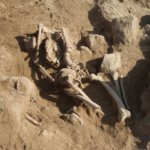In 2014, during the second season of the joint Armenian-Polish archaeological mission, we decided to continue the work on the northern terrace of Mets Blur hill, where, in the previous season, we had promising results. The season lasted from the last days of September until the end of October, considerably longer than in the previous year. Due to the unclear dating and stratigraphic relationship of the architectural remains uncovered in the two separate test-trenches during 2013, we chose the method of area excavation to gain a broader view of the architectural layout of the lower-town. Before the work began in earnest, the old plan of the site, drawn during the excavations of Emma Khanzadyan, needed to be digitized and corrected. A new grid system was set up covering the entire area of the site. The terrain was divided into 25 sectors (100 x 100 meters), each containing 400 squares (5 x 5 m). This year’s excavation focused on two areas: trench A (in sector IX) and B (in sector VIII). During the fieldwork, the initial 5 x 5 m trenches were extended significantly: trench B towards the north and west, while trench A towards the south and west, eventually the two areas were joined together. In the latter, the work was concentrated inside the oval structure uncovered in the previous year and the area adjoining it from the south. During the excavation, a new N-S orientated wall was discovered, it was clearly connected to the oval room from the south and probably formed part of an adjoining room. Unfortunately, the construction was badly preserved, only the foundation level of the wall survived. Thanks to the pottery sherds found within the area we were able to date the structure to Iron Age I (late 12th – early 8th century B.C.). Approx. 5 m to the south we discovered an irregular stone platform. Along the north-eastern side of the structure the remains of an older wall so as an intact black-polished jar (9th century B.C.) were unearthed in situ.
Trench B provided similarly interesting results. The team uncovered the remains of a square building dated to the Urartian period (8th-7th century B.C.). The area around the structure showed traces of destruction and violence. Two skeletons of young men (25-30 years old) were found in the vicinity of the Urartian building. The first individual, located in the southern part of Trench B, was beheaded, his skull was found 5 m from the rest of his body. While, the second skeleton, in the north-western corner of the excavated area, showed signs of trauma on the chest. Only a few objects were found nearby the human remains. An ornamented fragment of bone horse bit was discovered in the vicinity of the first body, whereas the second individual „held” in his right hand a small jar with a trident motif incised on its surface. This symbol usually refers to the god Haldi, the main deity of the Urartian pantheon. Therefore, we dated the skeletons to the late Urartian period. The most likely candidates for the destruction and murders are either the Scythian or Cimmerian tribes who invaded the territory of the Urartian kingdom at the end of the 7th century B.C.
Team members: Prof. Ashot Piliposyan, Dr Krzysztof Jakubiak, Miqayel Badalyan, Artavazd Zaqyan, Tigran Zaqyan, Tatiana Adamowska, Mateusz Iskra, Justyna Łukaszewicz, Julia Maczuga, Marcin Okniński, Marek Truszkowski, Piotr Zakrzewski, Martin Malata, Jan Marko
Back to publications



